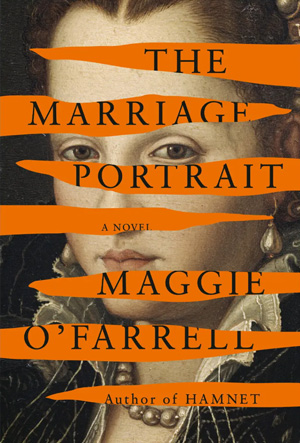My book group chose Maggie O’Farrell’s latest novel for our next meeting, and—just, wow. Even before I got to the first chapter, she had this reader asking two very key questions: is the main character crazy, and will she be killed or die on the next page or in the next section? Best of all, the author kept me wondering right up until the final pages—and I’m not going to reveal any answers here, so please read on.
In that opening Historical Note, we learn that Lucrezia di Cosimo de’ Medici started her married life at age 15 and died less than a year later. “The official cause of her death was given as ‘putrid fever,’” it explains, “but it was rumoured that she had been murdered by her husband.”
Hmm.
When I turned the page, Chapter 1 (entitled A Wild and Lonely Place, dated 1561) shows us the world through this very young bride’s eyes:
Lucrezia is taking her seat at the long dining table, which is polished to a watery gleam and spread with dishes, inverted cups, a woven circlet of fir. Her husband is sitting down, not in his customary place at the opposite end but next to her, close enough that she could rest her head on his shoulder, should she wish; he is unfolding his napkin and straightening a knife and moving the candle towards them both when it comes to her with a particular clarity, as if some coloured glass has been put in front of her eyes, or perhaps removed from them, that he intends to kill her.
After a few paragraphs of grounding backstory, we move back into the scene:
Lucrezia’s fingers grip the rim of her plate. The certainty that he means her to die is like a presence beside her, as if a dark-feathered bird of prey has alighted on the arm of her chair.
I was completely entranced as a reader all the way through, but now that I’ve finished the book I’m even more impressed as a writer. The hardest way to tell a story is to let it drip and dribble out of carefully plucked details—and that’s exactly what O’Farrell has managed. She takes us into the mind of a duchess in Renaissance Italy and somehow brings that faraway world back to life.
Is she going to die? I kept wondering—which was tightly intertwined with: can I trust what Lucrezia—the only window into this strange world—sees and hears and feels? Is this conspiracy all in her head? And, most importantly, is her new husband a heartless villain or a respect-worthy statesman who loves her?
The novel jumps around in time, and especially in the final quarter of the book I couldn’t always follow whether we were in the “now” or the “then”—even though they were told in different tenses—or how much time had passed. It was, perhaps, a fringe benefit of the very deft and seamless writing, and in the end it simply didn’t matter exactly what day it was; each section advanced the story inevitably toward the answers I was seeking.
(All I will say about the ending is this: it was incredibly satisfying, and not nearly as dark as I expected.)
I usually try to hold off finishing a book until just our next meeting, but in this case I couldn’t stop reading until my questions were answered. This is the third book we’ve read by Maggie O’Farrell, and it’s by far my favorite to date. Born in Ireland and now living in Edinburgh, O’Farrell has woven together what could be a heavy tale without any heavy-handed telling; feeding us a steady and not-quite-enough drip of information through carefully selected detail and imagery. As a reader, I was entranced; as a writer, I was jealously impressed. I can’t wait to see where her muse takes her next.

Great post, your review would get anyone excited to read The Marriage Portrait.
Thanks Paul but not your kind of book!
Sooo so so good! I am thrilled you read this, and loved it too!
Read on, book-soul-sister! 🤩 Lynne
Thanks Lynne!
I was hooked from the first page and could not put it down. Beautifully written. I also was confused regarding time frame in the last quarter of the book but, as you said, it didn’t matter regarding the plot. The ending is surprising!
Glad you enjoyed it as much as I did and lots to discuss!